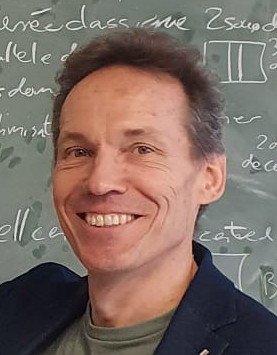|
| :: Teaching Interests |
|
My teaching interests are both in Mathematics and Computer Science: in
addition to undergraduate courses in both areas, I am interested and
qualified to teach at the graduate level Scientific Computing,
Numerical Differential Equations, Matrix Computations, Differential
Equations, Parallel Computing, Numerical Dynamical Systems, Algorithms
and Data Structures and Object Oriented Programing.
|
|
|
| |
| :: Courses I teach this year in Geneva |
Analyse numérique des équations aux dérivées partielles:
Beaucoup de phénomènes physiques peuvent être modélisés par des
équations aux dérivées partielles, par exemple le flux d'un fluide
dans un tuyau, les variations de température à l'intérieur d'un
appartement ou la cuisson dans un four à micro-ondes. Mais la
résolution de ces équations est souvent difficile et les méthodes
analytiques suffisent rarement pour obtenir les résultats désirés.
Ce cours est une introduction aux méthodes numériques modernes pour la
résolution des équations aux dérivées partielles. Nous utiliserons
Matlab pour développer des codes modèles simples, et Maple pour nous
assister dans les calculs symboliques.
|
|
|
| |
| :: Teaching Experience |
Differential Equations (McGill 2004):
Introduction to differential equations: first order and linear second order
equations, higher order equations, solution by series,
Laplace transform and simple numerical methods.
Ordinary Differential Equations (McGill, 2003):
Introduction to ordinary differential equations: first and second order
equations, linear equations, series solutions, Frobenius method,
Laplace transforms and applications.
Introduction à l'analyse numérique I (Genève, 2003):
A first undergraduate course introducing students from mathematics and
computer science to numerical integration, interpolation and
approximations, numerical ordinary differential equations and linear
systems. (40 students, 2 hours lecture, 1 hour exercises and 2 hours
Fortran exercises)
Introduction à l'analyse numérique II (Genève 2003):
A second undergraduate course introducing students from mathematics and
computer science to more advances topics in numerical analysis: iterative
methods, eigenvalue and eigenvector computations and nonlinear systems.
(40 students, 2 hours lecture, 1 hour exercises and 2 hours
Fortran exercises)
Numerical Differential Equations (McGill, 2000-2002):
A graduate course in numerical methods for ordinary and partial
differential equations, including Runge-Kutta, Linear Multistep and
adaptive methods, finite elements, finite differences, finite volumes
and spectral methods, fast solvers. (20 students, 4 hours lecture, exercises with Matlab and Maple)
Numerical Analysis (McGill, 1999-2001):
A graduate course in numerical methods, with linear and nonlinear systems,
iterative methods, eigencomputations, quadrature, approximation.
(20 students, 4 hours lecture, exercises with Matlab and Maple)
Parallel Computing using Domain Decomposition (Summer course TU
Denmark 1999): An introduction to domain decomposition methods. (25
students, 1 week lectures with exercises)
Introduction to Scientific Computing (Stanford, 1996-1997): An
advanced undergraduate, early graduate course in scientific computing
using Maple and Matlab. (30 students, 3 hours lecture and exercises)
Programming Paradigms (Solothurn, 1993): An introduction to
the different programming paradigms using Object Pascal, Lisp and
Prolog. (20 students, 2 hours lecture with exercises)
Introduction to Computer Science II (Solothurn, 1990-1992):
Algorithms and datastructures in Pascal. (18 students, 2 hours
lecture with exercises)
Introduction to Computer Science I (Solothurn, 1990-1992): An
introduction to basic algorithms and programming in Pascal. (20
students, 2 hours lecture with exercises)
|
|
|
| |
| :: Fun Problems and Talks |
-
A survey talk I gave at the university of Geneva for a large group of visiting students from Greece.
-
Think about an ice cube in a glass of water. Mark how high the water is
before and after the ice cube has melted. What do you observe?
-
The couch
moving problem
- Suppose you are playing billiard on a circular billiard table. If there are two balls, what direction do you have to kick the first ball so it impacts on the boundary of the table exactly once before hitting the other ball ? What does this have to do with the heart shape you see in your coffee mug ? See our
paper in SIAM: Circular Billiard.
-
Equilateral
triangle circumscribing a given triangle (in German)
-
Square
circumscribing a given quadrilateral (in German)
-
Have you ever noticed that whenever you look at a table of numbers, more
of the numbers start with the digit 1 or 2 than with bigger digits. If
not, take your daily newspaper, open it in the business section and check
a few tables. Why is that so ?
-
A calculus
problem solved with Maple
-
A
geometrical proof of the theorem of Pytagoras (by my friend Antonio
Steiner)
-
A patrol vessel has to get within a specified distance of a target vessel.
Both vessels are traveling at constant speed on a plane. What is the minimum
time needed for the patrol vessel to get there ? See my note in SIAM:
Note on
the Optimal Intercept Time of Vessels to a Nonzero Range
-
Into how many pieces can you cut a doughnut (a torus) with three planar
cuts, without moving the donut ? Is the following solution correct ?
|
|
|
|


